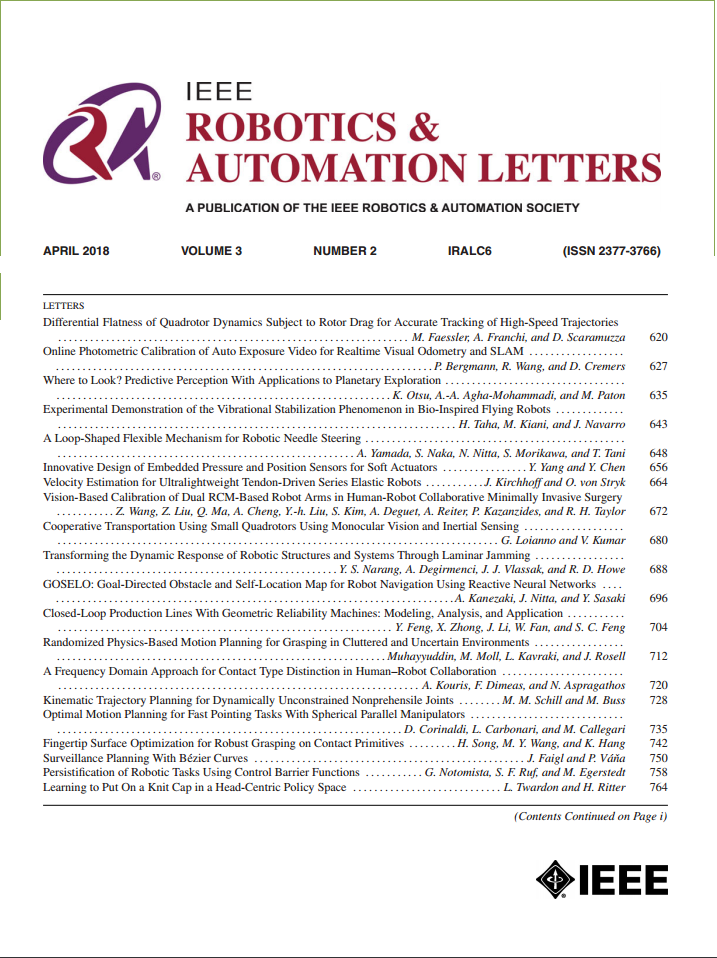WireFlie: A Novel Obstacle-Overcoming Mechanism for Autonomous Transmission Line Inspection Drones
IF 4.6
2区 计算机科学
Q2 ROBOTICS
引用次数: 0
Abstract
Robotic inspection of transmission lines presents significant challenges due to the complexity of navigating along the wires. Existing systems often rely on either flight modes for visual inspection or articulated crawling mechanisms for contact-based inspection. However, these approaches face limitations in effectively bypassing in-line obstacles or pylons, which are common in transmission line environments. This letter presents WireFlie, a novel hybrid robotic system that integrates rolling and flight modes to overcome these challenges. The system consists of a pair of underactuated arms mounted on a drone platform, designed for secure, collision-free locking and detaching, enabling seamless transitions between locomotion modes. WireFlie supports both single-arm and dual-arm rolling, allowing it to bypass in-line obstacles such as Stockbridge dampers, dual spacers, and sleeves, and to overcome larger obstacles like pylons using flight. Additionally, we propose a high-level controller for autonomous locking, detaching, and obstacle avoidance. Experiments are conducted on a custom-made setup that closely resembles a transmission wire. We evaluate both the design and control aspects of our system, with results including kinematic analysis, wire detection, autonomous locking and the corresponding trajectory, and obstacle detection and avoidance strategies. This research contributes to the field of robotic infrastructure inspection by merging aerial and wire-based locomotion, providing efficient and autonomous monitoring of power lines.WireFlie:一种用于自动输电线路检测无人机的新型障碍克服机制
由于沿导线导航的复杂性,传输线的机器人检查提出了重大挑战。现有的系统通常依赖于目视检查的飞行模式或基于接触的检查的铰接爬行机制。然而,这些方法在有效绕过传输线环境中常见的线内障碍物或塔时面临局限性。这封信介绍了WireFlie,一种新型混合机器人系统,集成了滚动和飞行模式,以克服这些挑战。该系统由一对安装在无人机平台上的欠驱动臂组成,设计用于安全,无碰撞锁定和分离,实现运动模式之间的无缝转换。WireFlie支持单臂和双臂滚动,使其能够绕过Stockbridge阻尼器、双垫片和滑套等在线障碍物,并通过飞行克服像塔架这样的较大障碍物。此外,我们还提出了一个高级控制器,用于自动锁定、分离和避障。实验是在一个与传输线非常相似的定制装置上进行的。我们对系统的设计和控制方面进行了评估,结果包括运动学分析、导线检测、自动锁定和相应的轨迹,以及障碍物检测和避免策略。该研究通过融合空中和有线运动,为机器人基础设施检测领域做出了贡献,为电力线提供了高效和自主的监测。
本文章由计算机程序翻译,如有差异,请以英文原文为准。
求助全文
约1分钟内获得全文
求助全文
来源期刊

IEEE Robotics and Automation Letters
Computer Science-Computer Science Applications
CiteScore
9.60
自引率
15.40%
发文量
1428
期刊介绍:
The scope of this journal is to publish peer-reviewed articles that provide a timely and concise account of innovative research ideas and application results, reporting significant theoretical findings and application case studies in areas of robotics and automation.
 求助内容:
求助内容: 应助结果提醒方式:
应助结果提醒方式:


